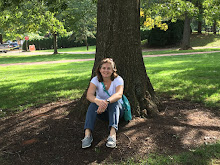Where Do Ideas Come From?
An Evening with Jimmy Gownley
I attended the book launch for
The Dumbest Idea Ever last night at
Hooray for Books.
Cartoonist, Jimmy Gownley drew throughout his presentation, creating characters to illustrate five sources of creative ideas.
He encouraged audience participation and had us all laughing with his stories and spontaneous comic characters.
So where does Jimmy Gownley get his ideas?
1. Inspiration - Sometimes they just come to him, maybe from a doodle or listening to music, something spontaneous.
He
also noted that inspiration becomes more likely with practice -
drawing, writing, playing music A LOT gets you ready for those moments
of inspiration.

2.
Yourself - Jimmy encourages telling stories about your own life. He
even said that the more embarrassing the story is for you - the more
likely it will make a GREAT story for other people to read!

3.
Other People - After yourself, other people's experiences, those of
family or friends also make great inspiration for stories.
With
other people or yourself, it is not about telling exactly what happened
but using what happened as inspiration in a story. His example last
night was a friend who "sneeze barfed" at dinner.

4. Your Medium
Medium
is artist-speak for what you use to make stuff. For Jimmy this is
comics so he used an example of how different types of speech bubbles
around the word "WOW" can make you say the word in different ways. This
is something comics can do that other kinds of writing can't. It is
interesting to think about other artistic media and what they can do.
For me I love collage because it can create something new while also
reminding people of familiar stuff. (See
COLLETTE for examples of this). What is unique about your favorite medium?

5. Influences
Influences
can be stories, artwork and artists you like. Jimmy described his own
influence from a comic where the character who didn't speak just had
thoughts written all over his shirt. Jimmy took this influence and
created a speechless character who wears pajamas and his emotions are
shown on him with emoticons.

Finally,
the kids in attendance got to call out a character (boy, girl, animal),
a job and a favorite movie or book. The group then worked together to
build characters around these ideas.
This also seems like a great way to get started creating your own characters and stories at home.
 "SNOW PEEP"
"SNOW PEEP" 